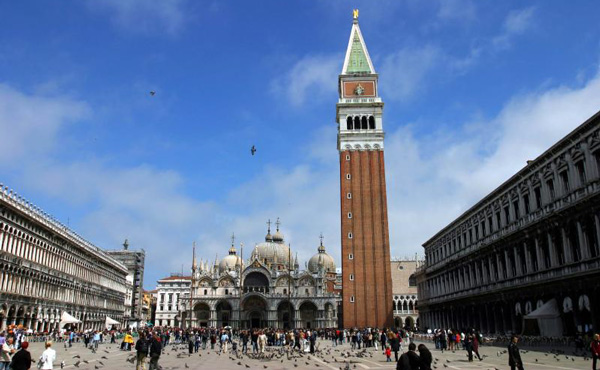The only space of the city to be called “piazza” (i.e. “square”, all the other are called “campi” or “campielli”), St Mark’s Square has always been the core of the city life. Although the square as appears now is characterised by a strong Renaissance taste, this area has begun to take shape in the Middle Ages, and throughout the centuries it has undergone several reconstructions and changes.

St Mark’s area began to become the monumental core of the city in 828, when St Mark’s relics were brought to Venice, but at that time the square was very different from how it appears now: the square, indeed, was bounded by Rio Batario, a canal that was buried in 1156, and by a basin in front of the Ducal Palace, which was buried too.
Throughout the centuries the square has been enlarged with new buildings and enriched also through the materials and the works of art which were brought from the East after the conquest of Constantinople in 1204. From the 15th century to the 19th century the square began to take the present appearance, with the renovation of Ducal Palace and the building of the Procuratie Vecchie, of St Mark’s Clocktower, of the Library, of the Procuratie Nuove and of the Ala Napoleonica.
Nowadays St Mark’s Square is a fixed destination for all the tourists that visit the city, who go there to experience the emotion of walking in one of the most beautiful squares in the world, but also to admire and visit the buildings that rise in this area and that make up the monumental core of the city. Among the most famous buildings in the Square, and in Venice in general, we cannot but speak about St Mark’s Basilica and Campanile (bell tower).
The Basilica, renewed and restored through the centuries, is characterised by a Byzantine, Venetian and Roman architecture (the façade decorated with golden mosaics is unmistakable) and hosts St Mark’s relics. The tower bell rises near the Basilica: once used as a lighthouse for boats, now it is one of the symbols of the city.
In this area we also find the Ducal Palace, another symbol of the city. Built in the 9th century, its present look comes from the works that took place between the 14th and the 16th century, and the monumentality and richness of both its interior and exterior were aimed at making everybody aware of the power and greatness of the Serenissima.
A Venetian Gothic masterpiece, the Ducal Palace was in the past residence of the Doge, seat of the government and courthouse, and nowadays is a museum.
Very interesting to visit is also the Correr Museum, which has its seat in the Ala Napoleonica, which was built in the 19th century. Born of a donation by Teodoro Correr (who died in 1830), with the passing of time the collection has enlarged and now includes several works of art, besides period costumes and objects. A donation, in this case by Giovanni Bessarione, gave birth to the Biblioteca Nazionale Marciana (National Library of St Mark’s) too: now it is one of the most important Italian libraries and has been visited, in the past and in the present, by important scholars.
Last but not least, among the monuments of St Mark’s Square we cannot forget St Mark’s Clocktower, a Renaissance building that was built at the end of the 15th century and that hosts the so-called “mori”, i.e. two bronze statues in the shape of two shepherds, who strike the hour on a bell.




